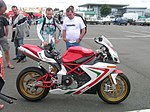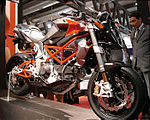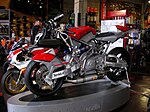Bimota
| Bimota | |
|---|---|
| legal form | Spa |
| founding | 1973 |
| Seat | Rimini |
| management | Federico Martini, Pierluigi Marconi |
| Website | bimota.it |
The Bimota SpA is an Italian motorcycle manufacturer based in Rimini , which in the past on the exclusive remodeling and finishing Japanese had specialized and Italian motorcycles. The company initially existed from 1973 to bankruptcy in 2000; the company has been back since 2005. In October 2019, Kawasaki took over 49.9 percent of Bimota, the previous owner, the Swiss Marco Chiancianesi, retains the majority stake in Bimota with 50.1 percent.
history
Racing
In 1973 Valerio Bi anchi, Giuseppe Mo rri and Massimo Ta mburini founded the manufacturer of motorcycle accessories Bimota from their respective first letters . Initially, the owners dealt with the development of suspension kits for the Yamaha TZ series ( TZ 250 , TZ 350 ), which drivers could purchase either as a complete package or in parts. 1975 was Johnny Cecotto motorcycle world champion in the class up to 350 cc Bimota Yamaha. This marked the international breakthrough for the manufacturer. Bimota developed special chassis for the racing departments of Harley-Davidson , Morbidelli and Paton in 1976 and 1977. The private driver Jon Ekerold was 1980 world champion in the class up to 350 cm³ on a Bimota-Yamaha. In 1987 Bimota won the Formula TT World Championship, the forerunner of the Superbike World Championship, with Virginio Ferrari on a Bimota YB-4 R.
series
In 1975 Bimota introduced its first street model, the HB-1 , which was based on the Honda CB750 Four . 1976 followed a chassis with the engine of the Suzuki GS 750 ( SB-2 ); The KB-1 with the engine of the Kawasaki Z1 , presented in 1978, was successful, of which 827 were delivered. The characteristic tubular space frame developed by Bimota , in addition to the full paneling, contributed significantly to the success of Bimota. In 1985 Massimo Tamburini moved to Cagiva , and Pierlugi Marconi was his successor as chief designer. In 1988, the tubular space frame in the model series was replaced by a bridge frame made of light metal profiles. In 1990 the unconventional Bimota Tesi 1D appeared on the wheel hub steering of which Giuseppe Morri held a patent.
Bimota found it increasingly difficult to sell its exclusive motorcycles in the 1990s. In addition to the high price, the reason was also the increasingly perfect series machines from Japan.
“Ambitious motorcyclists [in the 1980s] had good reasons to buy a Bimota. After all, the extremely torsion-resistant chassis helped it achieve fantastic driving characteristics, compared to the 'wobbly buckets' that the Japanese motorcycle industry offered at the time. […] The times are now over, the Japanese high-volume machines have long set the standards. "
Bimota always used top models from Honda , Kawasaki , Suzuki and Yamaha for their street bikes - with their own frames and accessories. In the model name, the first letter stands for the manufacturer of the engine, the second letter stands for Bimota, and the number is a sequential number, it indicates the model series. Thus, for example, HB-1 means : Honda engine (H), Bimota model (B), the first model (1). The most common names are:
An exception to the model designation forming the VdÜ with its own two-cylinder - V - two-stroke engine and the Tesi models with Ducati engine and an unusual hub-center steering - what the Italian word tesi ( dt. Thesis ) alludes.
1975 to 2000
By 1999, Bimota had produced 49 different models for the road and more for racing.
| model series | construction time | engine | Quantities | image |
|---|---|---|---|---|
| HB-1 | 1975-1976 | Engine of the Honda CB750 Four | 10 |

|
| SB-1 | 1976-1980 | Racing motorcycle, engine of the Suzuki TR 500, weight about 120 kg. | ~ 50 |

|
| SB-2 | 1977-1979 | Engine of the Suzuki GS 750 . A second version, the SB2 / 80, followed in 1980 with 30 units. It had a tubular steel frame that was split at the level of the cylinder head, and was connected there on each side with a cone joint with only three 6 mm screws. Another special feature was the swing arm bearing positioned at the height of the chain sprocket, which allowed the chain slack to be extremely minimized, as there was no change during compression. Thanks to its lightweight construction, including magnesium wheels, its weight was around 180 kg. | 140 |

|
| KB-1 | 1978-1982 | Engine of the Kawasaki Z1 | 827 |

|
| SB-3 | 1980-1983 | Engine of the Suzuki GS 1000 | 402 |

|
| KB-2 | 1981-1984 | Engine of the Kawasaki 500/500 | 177 |

|
| HB-2 | 1981-1984 | Engine of the Honda 900 | 193 |

|
| SB-4 | 1983-1984 | Engine of the Suzuki GSX 1100 | 272 |

|
| YB-5 | 1987-1988 | Yamaha 1200 engine; the first production model with a Yamaha engine. | 208 |

|
| Tesi 1D | 1990-1991 | Ducati 851 engine with wheel hub steering | 127 |

|
| YB-10 | 1991-1994 | The engine of the Yamaha FZR 1000 Exup 3LE, was the last model of the YB series with fiberglass fairings | 224 |

|
| DB2 | 1993-1995 | Ducati 900 SS engine | 408 |

|
| SB-6 / R | 1994-1998 | Engine of the Suzuki GSX 1100 W; Frame breaks and damage to the self-supporting stern were reported. The 200 SB-6 Rs built between 1997 and 1998 were basically a necessary response to criticism of the SB-6. In this model, the vulnerabilities have been revised. The frame was reinforced and provided with a much more stable steering head. The GRP frame rear was built in carbon, and the fairing was also changed. The intake and exhaust parts have been better coordinated and the performance of the 1100 is now optimally used. The 6R was the last four-cylinder Suzuki-engine motorcycle to be launched by Bimota. | ~ 1144 |

|
| SB-7 | 1994-1995 | Engine of the Suzuki GSXR 750 W SP version | 200 |

|
| YB-9 / SRi | 1994-1998 | Engine of the Yamaha FZR 600. The four-cylinder in-line engine with 599 cm³ achieves 74 kW at 11,500 rpm, the maximum speed is 250 km / h, and the dry matter 175 kg. Paioli elements are used on the front fork and shock absorber, while 320 mm double-disc brakes from Brembo are used at the front and 230 mm single-disc brakes at the rear. In 1996 the SRi came out, which u. a. an injection instead of a carburetor and wider 180 tires compared to the 160 tires of the predecessor. 225 copies of the YB-9 Sri were made. | 651 |

|
| BB-1 | 1995-1997 | Engine of the BMW F 650 | 376 |

|
| YB-11 | 1996-1998 | Engine of the Yamaha 1000. This model of the YB series was the last construction stage with the five-valve valves from Yamaha. In contrast to the previous models such as YB 6/8/10, the YB 11 had the engine of the Yamaha Thunderace with the designation YZF 1000R 4SV. The 1000R has the camshaft drive like the FZR engines in the middle between the cylinders, while the R1 has it on the side. The YB 11 is equipped with two seats | 650 |

|
| Vdue | 1997-2005 | The short-stroke (bore 72 mm, stroke 61.25 mm) 2-cylinder two-stroke engine has a displacement of around 500 cm³ with the cylinders in a 90 ° V position. Each piston works on its own crankshaft, which is coupled via gear wheels. The direct injection used in the first development phase was abandoned in favor of 39 mm Dell'Orto carburetors. Inlet control is done by membranes, the outlets are controlled by slides. The primary drive to the 6-speed gearbox is also provided by a gear, the multi-plate dry clutch is operated hydraulically. Bimota indicates the performance of test machines with 110 HP. | 150 |

|
| SB-8K | 2000 | Engine of the Suzuki TL1000 . This motorcycle was part of the Bimota program even before it was re-established, but at the time with the additional letter R. There were two different models, as today, the standard version SB8 R and the SB8 R Speziale, in which the entire fairing is made of CFRP. The stern was self-supporting, so it didn't need an additional rear frame. The model was developed for use in the Superbike World Championship and produced in the quantities required for participation in this championship. Today's version of the SB8 is again available in two versions. On the one hand in the variant Santamonica and on the other hand in the variant Gobert, which is supposed to remind of the use of the SB8 in the year 2000 in the Superbike World Championship with the driver Anthony Gobert. This put the SB8 in first position in the first race of the season. The SB8 is characterized by a special feature: The frame consists of a composite of aluminum and CFRP. The two components are glued and screwed together and form a bridge frame. Another special feature is hidden. The injection nozzles are arranged radially on the SB8 K. Bimota has patented this arrangement. This model also follows the Bimota philosophy for lightweight construction; the SB8 K weighs only 175 kg. | ~ 150 |

|
Since 2005
| model series | construction time | Engine and technology | image | |
|---|---|---|---|---|
| DB-5 Mille 992 | 2006-2007 | The DB5 Mille is a lightweight faired sports motorcycle and was built from 2006. Bimota has evaded the current horsepower arms race of the major manufacturers and instead relies on lightweight construction, which is expressed in a low dry weight of 165 kg. The heart of the DB5 Mille is the air-cooled 90 ° V-Twin 1000 Mille from Ducati with 992 cm³ displacement and its torque-oriented coordination. Bimota stated the maximum output was 92 hp at 8,000 rpm and the maximum torque of 92 Nm was 5,500 rpm. The chassis is made of a CrMo steel - tubular frame with milled aluminum -Seitenteilen, a TiN-coated 43 mm Öhlins - upside-down fork and a 120 mm Mono strut fully adjustable also by the manufacturer Öhlins. Two Brembo front wheel brakes, each with 4 radial cylinders and 298 brake discs, as well as 2 brake cylinders and a 220 brake disc at the rear, slow the machine down. | ||
| DB-5S RE 1100 | 2007– | The DB5S RE is a lightweight faired sports motorcycle and was introduced to the public in 2007. Dry weight of 185 kg. The heart of the DB5 is the air / oil-cooled 90 ° V-Twin 1100 DS from Ducati with a displacement of 1079 cm³ and its torque-oriented coordination. Bimota specifies a maximum output of 70 kW at 7,750 rpm, the maximum torque of 94 Nm is 4,000 rpm. The chassis is made of a CrMo steel - tubular frame with milled aluminum -Seitenteilen, a TiN-coated 50 mm Marzocchi RAC upside-down fork and a 130 mm Mono strut fully adjustable by the manufacturer extreme Tech. The latter is operated directly by a filigree truss cantilever rocker made of a steel-aluminum composite. |

|
|
| DB-5R 1100 | 2007– | In the middle of 2006 Bimota presented another DB-5 variant, the DB-5R. It differs from the DB5S 1100 by a total of 4 kg lighter OZ forged wheels, a titanium exhaust system from ZARD with adapted mapping of the control unit, a larger Brembo rear wheel brake with 230 instead of 220 brake discs and an anti-hopping clutch . Various paneling parts are made of carbon fiber reinforced plastic ( carbon fiber , carbon, CFRP). Adjustable Öhlins dampers complete the picture. Bimota gives approx. 5 HP more power and approx. 10% more torque for the DB5R, the dry weight is 169 kg. |

|
|
| DB-6 Delirio / 6R | 2007– | The DB-6 Delirio , presented in 2006, is the naked bike variant of the DB-5 . With this it is technically largely identical. The engine, frame and swing arm are identical, but the rider has to do without the Öhlins suspension components and have to be content with a TiN-coated 50 mm Marzocchi upside-down fork and an Extreme-Tech shock absorber. The motorcycle is piloted with a butted handlebar instead of handlebar stumps. The front and rear have their own design. The curb weight is 177 kg. After Ducati increased the DS engine from 992 to 1,079 cm³, this displacement variant was also used in the DB-6 Delirio . At the end of 2007, Bimota presented the DB-6R at the EICMA motorcycle fair in Milan . In contrast to the standard version, the R version has forged wheels as well as various changes and add-on parts made of carbon. The DB-6R is hereby seven kilograms lighter than the DB 6 Delirio . |

|
|
| DB-7 | 2008– | At the end of 2007, Bimota presented their newest and most powerful model to date. With the completely redeveloped DB-7, the old superbike tradition of the company is to be linked. Unlike the current DB models, the current Ducati four-valve engine with 1099 cm³ (Testastretta Evolution-V2) is used as the drive . The composite frame consists of a mix of oval steel tubes and milled aluminum plates. The rear swing arm is also constructed according to the same composite principle. The suspension elements are supplied by Marzocchi ( upside-down fork ) and Extrem Tech (shock absorber) and are fully adjustable. The braking system consists of two four-piston Brembo monobloc calipers at the front , which are screwed radially, and a Brembo double caliper at the rear. The brake lines are steel-sheathed and the wheels are made of forged aluminum. In order to achieve the dry weight of 170 kg specified by Bimota, the upper part of the cladding and the bench were made of carbon fiber reinforced plastic in a self-supporting construction. With this construction, the instrument holder and rear frame could be omitted. The exhaust muffler sits on the side and not under the seat like other DB models. This also saves weight, as there is no need for an elaborate manifold guide and the center of gravity moves more to the center of the motorcycle. With this model, Bimota plans to enter the Superbike World Championship in the future and thus revive and continue the brand's racing tradition. The DB-7 would inherit the SB-8, which was the last Bimota model to officially take part in a world championship (in 2000 ). |

|
|
| Tesi 2D | 2005-2006 | The Tesi 2D is the further development of the Tesi 1D from 1991. After the bankruptcy of Bimota, the small Italian company Vyrus took over the Tesi 1D and presented further developments at trade fairs. The Tesi 2D is again a pure Bimota product. The wheel hub steering - a variant of the kingpin steering - is typical of both Tesi 2D models . The development of this front wheel guide at Bimota goes back to the eighties. It should actually be used in Grand Prix motorcycle racing together with the self-developed V2 two-stroke engine. Another special feature is the construction of the frame. This is formed by two elaborately milled aluminum plates in omega shape. Subframes for the rear frame and for holding the steering head are screwed to this. The front suspension strut is attached to the side in a striking way. The air / oil-cooled Ducati V2 engine with 1079 cm³ complied with the Euro 3 standard. The motorcycle weighs 168 kg when ready to drive. |

|
|
| Tesi 3D | 2007– | Compared to the Tesi 2D, the front swing arm was designed in a lattice construction made of chrome-molybdenum tubes, Bimota describes the steering as "mechanically operated steering knuckle ". The 1100 Ducati engine was retained and is specified with 98 hp maximum output at 7500 rpm, the "dry weight" is 167 kg. |

|
|
In October 2019, the Bimota Tesi H2 was presented, which is equipped with the 200 hp supercharged four-cylinder engine of the Kawasaki Ninja H2 and is to be built from 2020.
literature
- Jürgen Gaßebner: Bimota. Motorcycles since 1973. Motorbuch Verlag Stuttgart, 1st edition 1999, ISBN 3-613-01991-4 .
- Schrader engine chronicle: Italo classics. Motorbuch Verlag Stuttgart, 1st edition 1997, ISBN 978-3-613-02828-9 .
Web links
- www.bimota.de
- www.bimota.it (Italian)
Individual evidence
- ↑ As early as 1965, a company for heating and ventilation systems was founded under the name Bi-Mo-Ta .
- ↑ a b Bimota Tesi H2 2020. In: motorrad-magazin.at. April 7, 2017, accessed August 4, 2020 .
- ^ Schrader Motor Chronicle: Italo Classics. P. 66.
- ↑ S. Ewald, G. Murrer: Encyclopedia of the motorcycle . Novara 1996. (German edition: Weltbild Verlag, 1999, ISBN 3-86047-142-2 ), p. 63.
- ↑ U.S. Patent 5,133,223 A
- ↑ Roger Hicks: The international encyclopedia motorcycles . Motorbuch Verlag Stuttgart, 1st edition 2006, ISBN 978-3-613-02660-5 , p. 74.
- ↑ Jürgen Gaßebner: Bimota. Pp. 15, 16.
- ↑ Jürgen Stoffregen: Motorcycle technology: Basics and concepts of engine, drive and chassis. Vieweg Verlag, Braunschweig, 7th edition 2010, ISBN 978-3-8348-0698-7 , pp. 330–331